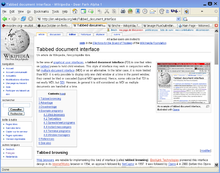Single Document Interface

Single Document Interface ( SDI ; German single document surface ) describes a form of graphical user interface for computer programs .
Programs with a single document interface display the data to be processed ( documents ) in just one main window . If another document is to be processed, a new main window is created. Well-known examples of programs with a single document interface are the Internet Explorer browser up to version 6 and the Windows editor.
Many graphical user interfaces (e.g. GNOME ) only know programs with a single document interface. If a user interface offers the possibility of nesting windows, this concept is called a Multiple Document Interface (MDI). The best-known example of a user interface with MDI functions is Microsoft Windows . As a third type, there are also dialog-controlled programs that are not structured in a document- centered manner and do not require their own main window (especially with a menu bar). The user interface is only represented by displayed dialog boxes ( dialog ). Mac OS works with a fixed menu line (at the top of the screen and not in the document window) and is therefore basically only assigned to the MDI.
The term single document interface goes back to the Model View Controller design pattern, which separates data and presentation, the data shown is called the design pattern Document .
The MFC library enables four different application types: SDI (Single Document Interface), MDI ( Multiple Document Interface ), MTI (Multiple Top-Level Windows Interface) and dialog-based applications.
